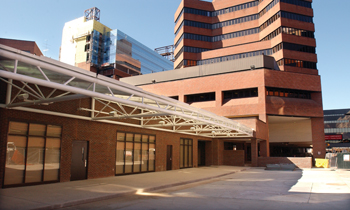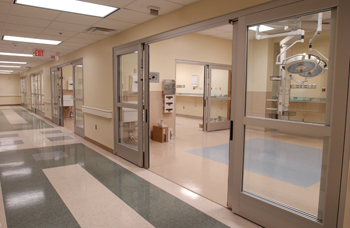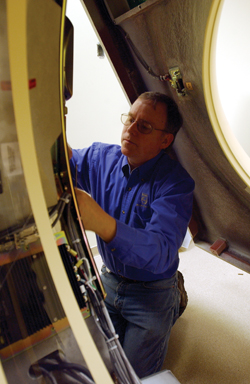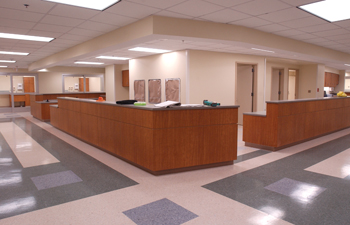
Vanderbilt University Medical Center’s new Emergency Department is nearly double the size of the previous one and features three ambulance bays. The new facility opens April 19.
photo by Dana Johnson
New Emergency Department readies for patient care debut

The new Emergency Department’s four state-of-the-art trauma bays come equipped with operating room-quality lighting and medical gasses that drop from the ceilings.
photo by Dana Johnson

Hank Lowe of Philips Medical Systems installs the new CT Brilliance scanner in the new ED.
photo by Dana Johnson

The centralized location of the nurses station in the new Emergency Department will help facilitate patient flow.
photo by Dana Johnson
Vanderbilt University Medical Center will debut the first phase of its sparkling new, state-of-the-art Emergency Department this month.
It provides more patient and family privacy and almost doubles the space from the previous facility.
The new Emergency Department will open on April 19. Patients seeking treatment there will find one of the most sophisticated emergency departments in Nashville.
“It's a great place for patients and clinical staff,” explained Corey M. Slovis, M.D., professor and chairman of Emergency Medicine. “We had a number of problems in the old ED with space and layout that affects how we do our jobs. It was designed in the 1970s and built in 1980 and was envisioned to be a clinic and walk-in area for a university hospital, not the home of a regional trauma center.”
The number of exam and treatment rooms rises from 27 to 46. The new area includes four trauma bays (equipped with operating room-quality lighting and medical gasses that drop from the ceiling), a family grief room, 16 acute care rooms, a second CT scanner, a classroom, a private registration area and an EMS workroom. Each of the patient care rooms has telephones and televisions to help family members be more comfortable.
The new ED also has a greatly expanded waiting room area for family and visitors, a new hazardous materials decontamination area, storage for stretchers and a conference and teaching center.
There are also new areas for psychiatric patients.
The current Emergency Department will be remodeled (scheduled for completion in July) and utilized for “fast track” patients, 23-hour observation, chest pain, stroke patients and ob/gyn patients.
“It is an emergency department that Vanderbilt and Nashville can be proud of,” said Brent Lemonds, R.N., MS, administrative director of Emergency Services.
Expansion of the ED is the first stage in a plan for a new, larger hospital facility to be built in stages over the next 10 to 15 years. This master development plan, which was endorsed by the Board of Trust in February 2002, features a third tower over the Emergency Department, allowing current areas of the hospital to be emptied and rebuilt one at a time.
The next phase of the project is tentatively scheduled for 2008, with the construction of four new floors above the ED, adding 75 inpatient beds and 12 new operating rooms at an estimated cost of $100 million. The new floors will integrate with the towers to form continuous floor plans.
The current footprint of the tower floors will be squared off and expanded.
Vanderbilt is the only Level One Trauma Center in the Middle Tennessee region and hosts the only Emergency Medicine residency program in Tennessee.
Physicians in the ED serve as medical control for Vanderbilt's LifeFlight air ambulance program, which flies more than 2,000 missions per year. Vanderbilt's adult Emergency Department sees more than 42,000 patients a year.













